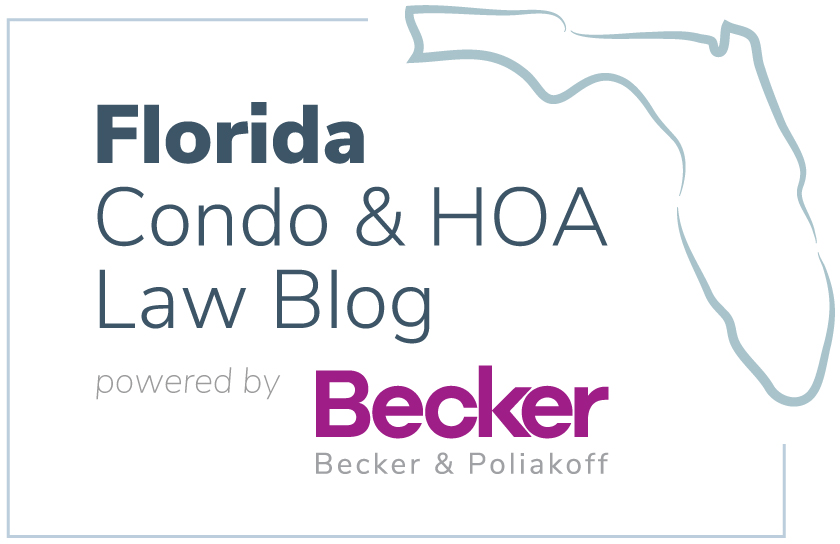
A well-designed disaster plan will include safeguards against future risk which are designed to minimize economic and property loss, as well as the loss of human life.
It is dangerous to ever become complacent about hurricanes when you live or own property in Florida. Knowing that disasters can occur and being prepared to deal with them will certainly minimize damages and promote a speedy recovery.
Disaster planning and recovery are two areas where communities should not attempt to go it alone. There are experts in all areas related to disaster planning and recovery who have the knowledge and experience needed to help you make the right decisions for your community. Unfortunately, there are countless stories of associations that misunderstood the perils of a disaster and its aftermath and paid the consequences for years to come.
Here are some helpful tips from other community association industry professionals to assist in developing your association’s customized disaster plan.
Adequate Insurance
Adequate property insurance must be based on the replacement cost of the property as determined by an independent insurance appraisal. Statutory mandates, along with provisions of the governing documents, determine the extent of the association’s insurance coverage responsibilities as well as those of the individual owners. For condominium associations, Florida Statute 718.111(11)(f) provides what must be covered under the association’s property insurance policy. The insurance market in Florida can be volatile and result in significant increases in premiums from one year to the next. Boards are encouraged to consult experts when making these decisions.
In addition to basic coverage, some major sources of economic loss, such as landscaping, fencing, screening, exterior building paint, building foundations, walkways, pools, tennis courts, and satellite dishes, are not normally covered by insurance. Some areas of potential loss can be covered for additional premiums including coverage for displacement from the property as previously discussed.
One of the most important types of coverage exclusions every board needs to discuss with its insurance agent is “ordinance or law” exclusion.
Ordinance or law exclusion states that the insurer will not pay for losses or damages caused directly or indirectly by the enforcement of any ordinance or law (1) regulating the construction, use or repair of the property; or (2) requiring the tearing down of any property, including the cost of removing debris. This exclusion is designed to address building codes that may require more expensive reconstruction material, installation, design or methods than those which were originally used in the existing building. The exclusion may also apply to environmental laws that require elaborate and expensive decontamination processes or upgraded construction practices in hurricane and flood zones.
For example, following Hurricane Andrew, a Miami-Dade County ordinance required that a number of buildings considered to be damaged by 50% or more could be restored only if they were elevated to a specific height above sea level. Under such circumstances, the cost of elevation plus repair of the damage generally would exceed the limit of building insurance, unless there was coverage provided under the rider to the base policy.
Many communities were left waterlogged by the hurricanes of 2004 and 2005 only to discover that their basic policies did not cover water damage from flooding. Under a typical master flood policy, the entire building is covered under one policy, including both the common elements and the individual units.
In the Florida Panhandle after events such as Hurricane Opal and the BP Oil spill, the greatest monetary loss was not damaged property, but lost rental income. Business interruption insurance is essential for owners or managers who rely upon vacation rentals for their livelihood.
Managers need to ensure that their business interruption coverage is not just for the premises where they maintain their offices, but also for the communities where they manage rental units.
Many homeowners failed to maintain coverage for their personal effects and improvements within their homes.
It is recommended that homeowners residing in shared ownership communities maintain homeowner coverage with at least these 4 endorsements:
- Loss Assessment Coverage
Protects against special assessments levied by boards to cover losses from covered peril, when the primary coverage is inadequate. - Water Seepage Coverage
Covers water damage from wind driven rain or water entering from a source other than an opening in the building (e.g., through stucco or around window frames). - Additions, Alterations Improvements and Betterments Coverage
Covers upgrades, as well as real property added by the unit owner. This endorsement is often available with all risk coverage, without a water seepage exclusion. - Insurance + Reserves
Even with adequate coverage, there is a risk that not every insurer will survive extraordinary claims. Hurricane Wilma’s, and most recently, Hurricane Ian’s and Hurricane Nicole’s widespread impact brought many insurance companies to their knees with some going out of business and the Florida Insurance Guaranty Association (FIGA) dealing with the aftermath. Careful consideration must be given to the financial strength and rating of the insurer as well as their consumer practices over the years. Keep in mind that the lowest quote is not always the most secure coverage. Given the current state of the insurance market, Communities who maintain reserves for contingencies, deductibles and other uninsured losses going to fare the best post-disaster.
Pre-Negotiated Service Contracts
Boards who enter into pre-negotiated contracts specifically designed to deal with the aftermath of a disaster often have the peace of mind that they have a set price and a designated contractor at their disposal.
These kinds of service contracts include:
- Emergency service contracts which provide “drying out” or “shoring up” the premises.
- Debris removal
- Security services
- Extraordinary management services.
“Insurance Trustee” Provisions
Generally found within the insurance section of the documents, these provisions require that the proceeds of insurance settlements be paid to a third party for disbursement at the instruction of the association’s engineer. When such a provision exists, insurers will not pay proceeds to the association until a trustee is designated. This can critically delay the receipt of funds necessary for disaster response as well as add an unnecessary cost to the association to pay for the Insurance Trustee. It is preferable for the board to act as a “trustee” with disbursements being authorized only when approved in advance by an independent engineer or construction manager employed by the association.
Emergency Powers
State laws and document restrictions designed to ensure owner access to information and input in the decision-making process previously impeded disaster recovery for condominium associations. Fortunately, the Condominium Act and the statutes for homeowner associations and cooperatives have been changed to provide emergency powers. (For a more detailed examination, please refer to the section ASSOCIATION EMERGENCY POWERS)
Even with the acquisition of emergency powers, your association’s governing documents should be reviewed and amended to remove any unnecessary barriers to recovery.
Reconstruction vs. Termination
The unit owners at several condominiums destroyed or severely damaged by hurricanes have been shocked to learn of a provision in their declaration of condominium which provided for automatic termination when damage exceeded a certain percentage, often fifty percent (50%) or more of the condominium, unless a majority of the total voting interests voted to rebuild within a short time period, often within sixty (60) days. In many of these instances, since the unit owners had scattered all across the country, the associations had to seek court relief to prevent the activation of the provision. These types of “auto-termination” clauses can be very problematic. If your association has such a clause, it is recommended to revise this language via amendment before the next hurricane strikes. It should also be noted that the Condominium Act was amended subsequent to the hurricanes of 2004 and 2005 to provide a method for terminating condominiums in the event of economic waste, disrepair of the property and when continued operation of the condominium is made impossible by law or regulation.
Survey the Property and Identify Areas Needing Priority Attention
Depending upon the nature and extent of the damage, it may be necessary to evacuate the premises and/or pursue temporary remedial measures and support for the condominium building(s), all with the assistance of a qualified professional. In some cases, it may be necessary to hire security personnel to protect against vandalism, theft and other criminal activities. In the case of widespread disaster, unit owners may not be able to depend upon local law enforcement agencies whose attention might be diverted to higher priority matters. Arrangements for security, debris cleanup and emergency repairs should be made as part of a disaster plan, not after the fact, when it will be difficult, if not impossible, to find help.
Beware the Quick Fix
Within hours of any disaster, the affected community will be besieged by companies and individuals looking for work and/or offering disaster recovery services. Some of these folks may have come to the disaster area from other states and many may be unlicensed and uninsured. Along with an influx of reputable disaster recovery professionals there will be the con men and profiteers who prey upon the misfortune of others. While still reeling from the shock of the disaster, it is often very tempting to sign the first contract presented to you. Resist that urge as experience has shown that these quick solutions are formulas for disasters of greater magnitude than those already suffered. It is always recommended for your association attorney to review any such contract before execution.
The old adage that “haste makes waste” truly applies in these situations. The best advice is to stick to your disaster plan which, hopefully, will include a plan that anticipates the five (5) phases of reconstruction:
- Project planning/scheduling
- Construction bidding
- Contract negotiations
- Construction/rehabilitation
- Project completion/close out
There are intervening steps you should take which may require contracts of short duration and for specific purposes. For instance, your immediate need in the aftermath of a windstorm may include covering damaged structures which are exposed to the elements with a tarp to protect from further water intrusion and exposure. These interim contracts should also be reviewed by your association attorney to ensure that proper precautions are taken. All reconstruction contracts need to be carefully reviewed and negotiated by your legal counsel to ensure that the association’s interests are protected.
Avoiding the Pitfalls of Disaster Recovery
Common pitfalls that plague associations following a hurricane strike include:
- Disputes frequently emerge between various insurance carriers (flood, windstorm, property) and the association over the nature and extent of damage, cost of repair or replacement, and/or whether appropriate mitigation efforts were put in place. It is important for the association to timely file its proof of loss. Be aware that if the insurer can prove that the association failed to cooperate, then payment due under the policy could be delayed or denied, regardless of the size of the claim. In addition, the association needs to ensure that its claim is accurate, as inaccurate claims can also result in the loss or delay in coverage.
- Claims made by owners against their boards over the alleged mismanagement of insurance claims and insurance proceeds. The association owes a fiduciary duty to the owners to exercise reasonable care in the pursuit of their insurance claims and management of any insurance proceeds received. It is also important to properly reconstruct the damaged property for several reasons, including the need to avoid providing the insurance carrier a potential excuse to not provide coverage when the next hurricane strikes.
- Claims of contractors, subcontractors, materialmen and suppliers, who were not paid by the general contractor, resulting in the associations having to pay double because of its failure to comply with Florida’s Construction Lien Law.
- Suits against contractors and subcontractors over poor quality repairs.
Restoration of the Property
Putting Your Professional Team in Place
Once conditions stabilize, the association’s disaster recovery team will be in a position to meet with trained professionals to assess the damage and begin recovery including:
- Architect/Engineer – Responsible for assessing the damage, preparing plans and specifications in accordance with new building codes, assisting in selection of construction manager and defining other reconstruction requirements.
- Construction Manager – Oversees selection of general contractor, competitive bidding and administration; directs and coordinates pay requisitions, change orders and all other activities of the parties; and resolves disputes.
- General Contractor – Employs and supervises laborers, supplies materials and builds project in accordance with architect’s/ engineer’s plans and specifications, under the direction of the construction manager.
- Attorney – Reviews construction contracts to ensure adequate protection for job performance and warranties, and compliance with applicable lien laws. Also helps to guide the board through the many legal requirements and “traps” which can surface during reconstruction.
Funding Repairs
There are several important considerations when it comes to funding repairs after a disaster.
- Governing Documents – A review of your governing documents; particularly, the “repair after casualty” section of the declaration often contains applicable procedures and requirements which impact reconstruction, the adoption of assessments to fund repairs, etc.
- Estimates of Costs – Immediately after deciding to rebuild or repair damage to property for which the association is responsible, the association must obtain reliable and detailed estimates of the cost to rebuild or repair.
- Construction Fund – The construction fund shall be disbursed to pay costs in the manner required by the board of directors of the association upon approval by a licensed and qualified professional employed by the association to supervise the work.
- Loan – Many associations opt to pursue a loan to fund some or all of the reconstruction costs not covered by insurance. A loan from the Small Business Association (SBA) may also be an option, often at lower interest rates. Many communities have decided to take a revolving line of credit well in advance of storm season so they have necessary funds at their disposal if needed year-round.
- Reserves – Reserve funds are also a possible source of funds which can be utilized immediately if they are for an “earmarked” purpose. Any use of reserves for an alternative or “non-earmarked” purpose will require owner approval.
Settling the Insurance Claims
Insurance policies need to be examined to ensure that “proof of loss” forms are filed within the time limit required under the policies. As a general rule, flood policies require that proof of loss be filed within sixty (60) days after the flood, although these deadlines are often extended. However, it is critical that the association is aware of the specific deadlines contained in their policies.
The adjuster employed by your insurance company is not the association’s advocate. His or her job is to properly evaluate the claim while also protecting the interests of the insurance company who employs/retained them. For this reason, many associations decide to hire their own public adjuster to shepherd their claim through the often convoluted claims process and serve as the association’s advocate. In many instances, the assistance of an independent public adjuster may be beneficial when dealing with the nuances of an often complex insurance policy.
Most adjusters will work for a contingency fee based upon a percentage of the insurance proceeds. As with other contracts, your association attorney can assist you in navigating the terms and conditions of the contract you are considering with a public adjuster and any others involved in emergency services or repairs. It is important to remember that public adjusters provide a specific set of services to adjust and value a claim. They cannot perform any activities related to the practice of law, such as filing a lawsuit to collect monies owed to you if your insurance company denies your claim or decides to greatly undervalue it; evaluating whether a release should be signed in order to recover insurance proceeds; or complying with complex post-loss duties to recover under the policy.






Recent Comments